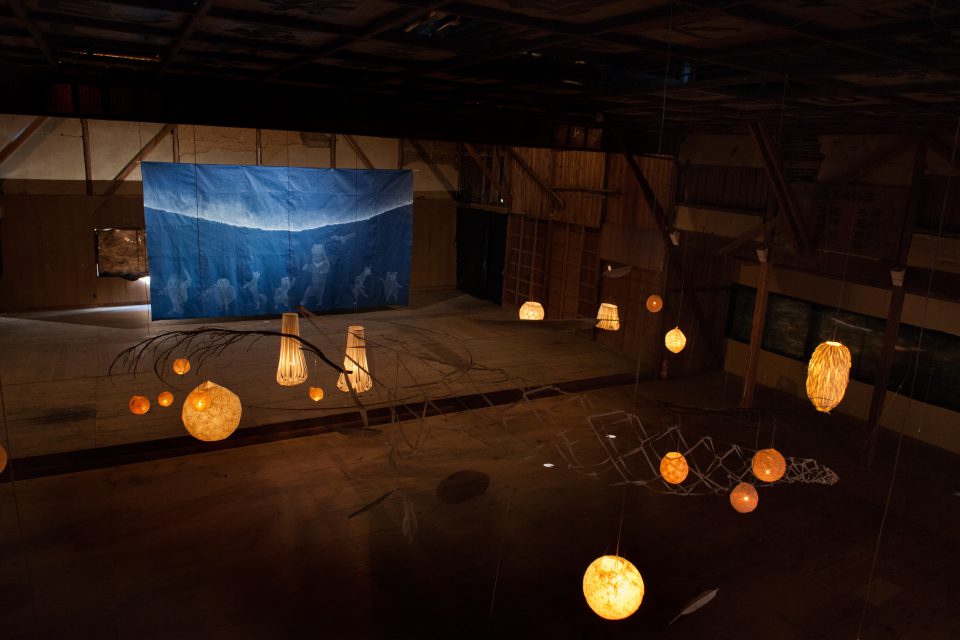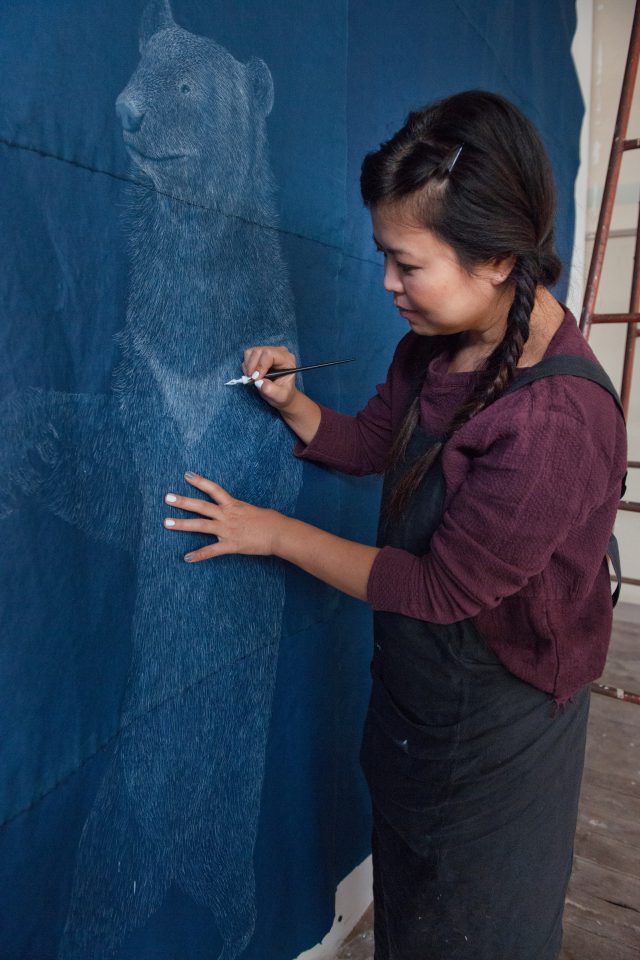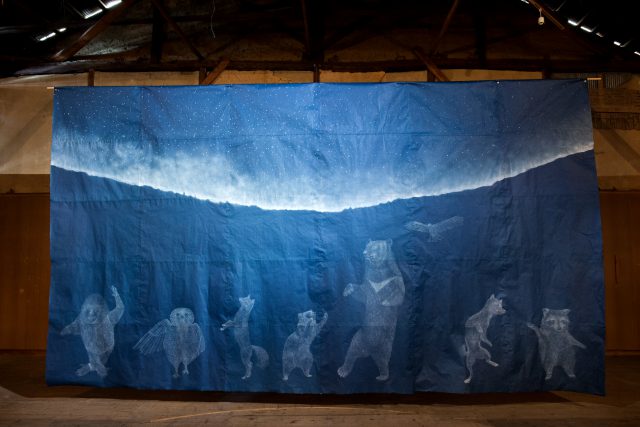
Masako Miki
2014 Kamiyama Artist in Residence participant
Masako Miki is a native of Osaka, Japan and now lives and works in Berkeley California. She received her MFA from San Jose State University. Miki’s work investigates internal conflicts concerning cultural identity. She examines psychological states of dichotomies, and metamorphosis. Her work often includes animals in absurd narratives. These animal motifs and their behaviors are used as a metaphor for the human psyche. The state of metamorphosis symbolizes an “in between” place; a place that doesn’t hold a specific form but it is in a flux where anything is possible. In this realm, boundaries are lifted from our perspective, which can expand further our perceptions. (text in 2014)
→ Masako Miki [HP]

a journey between places
Places with no shape. Places where possibility exists. I think this work began with the question of how such things can be expressed as a shape. Until now, I’d made works based on themes like metamorphosis, natural selection, and the process of animal evolution. For example, the way a whale uses echolocation on the sea bed by transmitting ultrasonic waves and transforming hearing ability into sight. This adaptation process of nature and living creatures in such a formless way may be necessary in order for them to survive. I wanted to make something that could only be made here during my Kamiyama art residence. For two months, I absorbed Kamiyama in my own way. I met many people, and visited many places. Then, I felt that perhaps Kamiyama as a whole is changing right now, like a single living thing. How will Kamiyama continue to change its shape, how will new elements combine with tradition? Kamiyama itself right now became a symbol of a “place with no shape”. Possibility, hope, anxiety, a place, people, spirit where all of that exists. I feel a limitless freedom here. Here, something new can be born. New values can be born. When you feel that, you can tap into an amazing sense of power and adventure. It might be my new life’s goal to spend as much time here as possible.
The lanterns are abstract versions of Kamiyama’s legendary serpent, and of Kamiyama objects such as sudachi, umeboshi, mushrooms, chestnuts, tanuki, and the cedar trees that surround the town. I also made the lanterns with the idea that they would be a method of connecting to things without a shape, which comes from the old idea that lanterns are a way to connect to spirits. For my drawings, I used paper dyed with Tokushima’s traditional indigo. The blue of the indigo has a beauty that can’t be expressed in words, and I was enchanted by the way the indigo blue color changed depending on the angle and the light. I depicted animals that have existed or do exist in Kamiyama in a motif where they are dancing Awa Odori. For me, the tradition of Awa Odori is a symbol of continuation. A wish that everything will continue from now on. I wanted to depict the unity and passion of the townspeople through Awa Odori.
The one thing about Kamiyama that personally made the biggest impression on me was its natural beauty. In particular, the starry sky at Shosan-ji Temple was so beautiful I could hardly believe it was an earthly scene. The stars looked like they were ready to overflow the sky. Stars and space are a motif that I use in my work. I think they are the unknown world that I feel closest too.
People travel to many places throughout their lives. In the end, I think the places where I feel most at home are places with the most basic elements, where I feel compatibility between myself and the land. But this is not something that can be simply explained; it can only be felt, but at the same time it is a definite feeling. When people choose a place where they belong, I think the first thing they feel is the beauty of that land. Then perhaps the people fascinated by that nature become new elements and bring new people there. It was the first time I was able to spend three months in Japan after twenty-two years in the United States, and one thing I was able to reconfirm was my own attraction to a place, and how a person can become their own home. This stay gave me one more place that I could call my home.
Exhibition at Yorii-za theater
[Drawing]
Materials Ink, Aizome indigo washi paper
Size 316cm x 556cm
[Installation]
Materials Washi paper, starch glue, wood glue, strings

[Comment]
After graduating high school, Masako Miki went to school in California, and she has continued to base herself in California since then. For Miki, the pursuit of identity is self-evident as she has spent 22 years living overseas as of the time of her residency. As an immigrant in the United States, there is surely anxiety and frustration, joy and anticipation, a complicated blend of emotions, and surely the animals she draws are speaking as proxy for such complexities of the heart. She mentions “metamorphosis” as a theme of her work, but it is “metaphor” that is indispensable to her as a way to express her desire to change. By encountering a spirit as those that appear in fables, one may encounter a new aspect of oneself by transforming into something that is not human. By doing this, one’s shell can be broken, and great leaps can be made. It could be that by newly transforming into an animal, one may acquire an attractive and abundant way of life.
Certainly, in Darwin's "Theory of Evolution" he said that animals are naturally culled and evolve. Living things are affected by nature and changes in the regional environment, and they adapt and change. In the United States, the people endured in the pioneer era by social values called Social Darwinism. Said another way, the survivalist spirit, through the repeated survival-of-the-fittest customs, has produced heroes. This is why a metamorphosis is necessary, and how the weak can become strong through incarnation.
The artist says that Kamiyama itself is a living thing. It might be a living thing that changes shape as it absorbs various things, like a giant whale, a transcendent presence with large breaths and undulations. The installation at Yorii-za is the artist’s imagining of a future Kamiyama. Individual works also have a narrative expressed within them, but the entire space itself is also expressed as a single work. Her impressions of Kamiyama as an abstract expression made visible, symbolized in multi-layered feelings of hope and possibility, fear and agitation. She selected common items from the surrounding environment for her organically-shaped lanterns, such as a legendary giant snake, a sudachi citrus, a pickled plum, a mushroom, a chestnut, a tanuki and more. The lanterns function as a medium to connect with the gods and for possession.
On a paper dyed blue with indigo, a product of Tokushima, animals dancing Awa Odori are drawn in white, on a background of blue. The monkey, fox, tanuki, owl, bear, and more are all animals that can be found in Kamiyama and are depicted in a simple way, giving the image an emotionally warm quality. As the artist stated, she wanted to depict a “connection between people and the passion of the town through Awa Odori.” She also says she wanted to depict the beauty of the nature she encountered in Kamiyama. Beyond the divine, shining mountain range is a sky scattered with stars. Kamiyama is a place for people’s daily lives, as well as a sort of distant myth-like presence.
Emiko Kato (Curator/Director of Art Aunotomy Network)